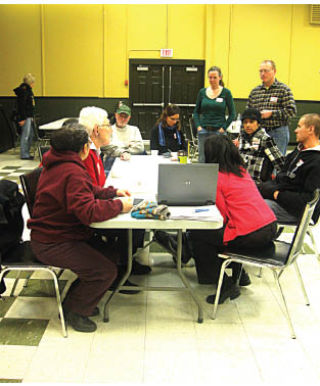The District of Invermere has taken its first steps towards how it will be approaching planning in the near future.
On January 15, the Invermere council and Community Sustainability Advisory Team (CSAT) held its first public-input presentation at Lake Windermere Memorial Community Hall.
The event was split into two presentations: one beginning at 9 a.m. that ran until noon, followed by a second presentation at 1 p.m. to 4 p.m. after a free lunch break for both session participants.
The presentation invited the community to share their input and ideas about the upcoming Integrated Community Sustainability Plan (ICSP), turning the event into a large brainstorming session.
“Things have been really positive, with good discussions and ideas,” said Gerry Taft, mayor of the District of Invermere. “There’s been a lot of enthusiasm. People are really taking a proactive approach.”
Invermere has received funding from the Federation of Municipalities through the Federal Gas Tax Revenue to support work with the Whistler Centre for Sustainability, as well as other independent consultants.
This new team, along with Invermere’s staff, have begun the development of an ICSP approach for the area.
An ICSP is a high-level policy document, with a vision, process and strategic plan for a community’s future.
It focuses on a comprehensive participatory process that spans the community and exists for the long term.
Invermere’s ICSP, named “Imagine Invermere”, is about “transformative change” and “incremental improvements”, described by Invermere’s ICSP website, imagineinvermere.ca.
“It helps to shape politics and community direction, as well as encompass environment, economical and social aspects,” said Taft.
Invermere’s ICSP will be developed by the CSAT, along with the community, as an ICSP developed by all community partners helps to better promote a coherent community plan for everyone.
The CSAT was created in November and December of 2010. Following the January 15 public input presentation, the Imagine Invermere process will begin drafting, with another public input presentation to be held in March or April of 2011.
It is hoped the ICSP will be implemented by April of this year.
Residents who participated in the January 15 presentation were introduced to the concept and initial ideas of the Imagine Invermere ICSP, then discussed their opinions and concerns about various sectors of the community to involve with the plan, such as the economy and jobs, energy, transportation, health, water and waste, land use, and planning buildings.
“We’re focused on doing things co-operatively in this region and trying to be self-sufficient,” said Taft.
More history and information, as well as a process timeline, is available to on www.imagineinvermere.ca. Guests on the website can also leave a comment on their views of the ICSP.
